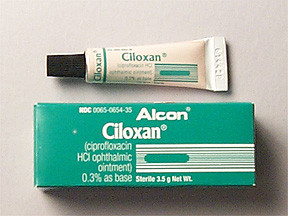CIPROFLOXACIN OINTMENT - OPHTHALMIC
PHONETIC PRONUNCIATION: (SIP-roe-FLOX-a-sin)
COMMON BRAND NAME(S): Ciloxan
GENERIC NAME(S): ciprofloxacin HCl
Uses
USES: This medication is used to treat eye infections. Ciprofloxacin belongs to a class of drugs called quinolone antibiotics. It works by stopping the growth of bacteria. This medication treats only bacterial eye infections. It will not work for other types of eye infections. Unnecessary use or overuse of any antibiotic can lead to its decreased effectiveness.
How to use CIPROFLOXACIN OINTMENT - OPHTHALMIC
HOW TO USE: Do not wear contact lenses while you are using this medicine. Sterilize contact lenses according to manufacturer's directions and check with your doctor before using them. Apply eye ointment to the affected eye(s) as follows: Wash hands first. To avoid contamination, be careful not to touch the tube tip or let it touch your eye. Tilt your head back, look upward, and pull down your lower eyelid to make a pouch. Place a 1/2 inch (1.5 centimeters) strip of ointment into the pouch by squeezing the tube gently. Look downward and gently close your eyes for 1 to 2 minutes. Roll your eyeball in all directions to spread the medication. Try not to blink and do not rub your eye. Repeat these steps for your other eye if so directed. Apply as often as directed by your doctor. Wipe the tip of the ointment tube with a clean tissue to remove excess medication before recapping it. If you are using another kind of eye medication (e.g., drops or other ointments), wait at least 5 minutes before applying other medications. Use eye drops before eye ointments to allow the eye drops to enter the eye. Use this medication regularly in order to get the most benefit from it. Continue using it for the full time prescribed even if symptoms disappear after a few days. Stopping the medication too early may allow bacteria to continue to grow, which may result in a relapse of the infection. Inform your doctor if your condition persists or worsens.
Side Effects
Precautions
Interactions
Overdose
Images
Reviews
Faq for CIPROFLOXACIN OINTMENT - OPHTHALMIC
Ciprofloxacin ointment is primarily used to treat and prevent bacterial infections in the eyes. It is commonly prescribed for conditions like conjunctivitis (pink eye), corneal ulcers, and other superficial eye infections caused by susceptible bacteria.
Ciprofloxacin is a broad-spectrum antibiotic that works by inhibiting the growth and killing the bacteria responsible for the infection. It does this by interfering with the bacterial DNA replication process, thus preventing the bacteria from multiplying and spreading.
It is recommended to wash your hands before applying ciprofloxacin ointment. Tilt your head back, and pull down the lower eyelid to create a small pocket. Squeeze a thin strip of ointment into the pocket, avoiding contact between the tip of the tube and the eye. Close your eyes gently, and roll your eyeball in all directions to spread the ointment evenly. Blink a few times to help distribute the medication.
Common side effects include temporary stinging or burning in the eyes, blurred vision, itching, redness, and a feeling of something in the eye. These side effects usually go away on their own. However, if you experience severe or persistent side effects, such as eye pain, watery discharge, or eye swelling, contact your doctor immediately.
It is generally recommended to avoid wearing contact lenses while using ciprofloxacin ointment. The ointment may interact with the lenses, leading to discomfort or reduced effectiveness of both the medication and the lenses. Consult your doctor for specific guidance on wearing contact lenses during treatment.
Follow the prescribed duration of treatment provided by your doctor. Typically, the treatment duration can vary from a few days to a couple of weeks, depending on the severity of the infection. It is important to complete the full course of treatment to ensure eradication of the infection and prevent its recurrence.
Disclaimer
IMPORTANT: HOW TO USE THIS INFORMATION: This is a summary and does NOT have all possible information about this product. This information does not assure that this product is safe, effective, or appropriate for you. This information is not individual medical advice and does not substitute for the advice of your health care professional. Always ask your health care professional for complete information about this product and your specific health needs.

No Reviews Yet